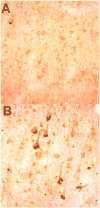Alzheimer's disease and brain development: common molecular pathways
- PMID: 9422711
- PMCID: PMC3674822
- DOI: 10.2741/a267
Alzheimer's disease and brain development: common molecular pathways
Abstract
Research on the causes and treatments of Alzheimer's disease (AD) has led investigators down numerous avenues. Although many models have been proposed, no single model of AD satisfactorily accounts for all neuropathologic findings as well as the requirement of aging for disease onset. The mechanisms of disease progression are equally unclear. We hypothesize that alternative gene expression during AD plays a critical role in disease progression. Numerous developmentally regulated genes and cell cycle proteins have been shown to be re-expressed or activated during AD. These proteins include transcription factors, members of the cell cycle regulatory machinery, and programmed cell death genes. Such proteins play an important role during brain development and would likely exert powerful effects if re-expressed in the adult brain. We propose that the re-expression or activation of developmentally regulated genes define molecular mechanisms active both during brain development and in AD.
Figures


Similar articles
-
Genetic complexity of Alzheimer's disease: successes and challenges.J Alzheimers Dis. 2006;9(3 Suppl):381-7. doi: 10.3233/jad-2006-9s343. J Alzheimers Dis. 2006. PMID: 16914876
-
Endocytic pathway abnormalities precede amyloid beta deposition in sporadic Alzheimer's disease and Down syndrome: differential effects of APOE genotype and presenilin mutations.Am J Pathol. 2000 Jul;157(1):277-86. doi: 10.1016/s0002-9440(10)64538-5. Am J Pathol. 2000. PMID: 10880397 Free PMC article.
-
Familial Alzheimer's disease: oxidative stress, beta-amyloid, presenilins, and cell death.Gen Pharmacol. 1998 Nov;31(5):675-81. doi: 10.1016/s0306-3623(98)00189-x. Gen Pharmacol. 1998. PMID: 9809462 Review.
-
[Alzheimer's disease due to presenilin mutations].Nihon Rinsho. 2004 Jan;62 Suppl:90-4. Nihon Rinsho. 2004. PMID: 15011327 Review. Japanese. No abstract available.
-
Presenilin function in APP processing.Ann N Y Acad Sci. 2000;920:158-64. doi: 10.1111/j.1749-6632.2000.tb06917.x. Ann N Y Acad Sci. 2000. PMID: 11193144 Review.
Cited by
-
Induction of cell-cycle regulators in simian immunodeficiency virus encephalitis.Am J Pathol. 2000 Aug;157(2):497-507. doi: 10.1016/S0002-9440(10)64561-0. Am J Pathol. 2000. PMID: 10934153 Free PMC article.
-
Location, location, location: altered transcription factor trafficking in neurodegeneration.J Neuropathol Exp Neurol. 2007 Oct;66(10):873-83. doi: 10.1097/nen.0b013e318156a3d7. J Neuropathol Exp Neurol. 2007. PMID: 17917581 Free PMC article. Review.
-
Response of cell cycle proteins to neurotrophic factor and chemokine stimulation in human neuroglia.Exp Neurol. 2001 Feb;167(2):205-14. doi: 10.1006/exnr.2000.7594. Exp Neurol. 2001. PMID: 11161609 Free PMC article.
References
-
- Braak H, Braak E. Neuropathological stageing of Alzheimer-related changes. Acta Neuropathol. 1991;82:239–259. - PubMed
-
- Levy-Lahad E, Bird T. Genetic factors in Alzheimer's disease: a review of recent advances. Ann Neurol. 1996;40:829–840. - PubMed
-
- Wisniewski H, Wegiel J, Kotula L. Some neuropathological aspects of Alzheimer's disease and its relevance to other disciplines. Neuropathol Appl Neurobiol. 1996;22:3–11. - PubMed
-
- Hutton M, Hardy J. The presenilins and Alzheimer's disease. Hum Mol Genet. 1997;6:1639–1646. - PubMed
-
- Haass C. Presenilins: Genes for life and death. Neuron. 1997;18:667–690. - PubMed
Publication types
MeSH terms
Substances
Grants and funding
LinkOut - more resources
Full Text Sources
Other Literature Sources
Medical
